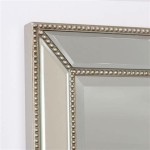How To Install a Large Heavy Mirror
Installing a large, heavy mirror requires careful planning and execution to ensure both safety and a secure mount. Improper installation can lead to damage to the wall, the mirror itself, and potentially injury. This guide provides a comprehensive approach to installing a large, heavy mirror, focusing on best practices for a successful outcome.
Assessment and Preparation are Key: Before beginning the installation, careful assessment of the mirror's weight and dimensions is crucial. Consult the manufacturer's specifications for accurate weight information. Measure the mirror precisely to determine the appropriate mounting hardware and placement on the wall.
Choosing the Right Mounting Hardware: Heavy mirrors require specialized hardware designed to support substantial weight. Traditional picture hangers are generally insufficient. Instead, opt for heavy-duty mirror clips, J-channels, or French cleats. These systems distribute the weight more effectively, minimizing stress on the wall and ensuring a stable installation. The specific hardware choice will depend on the mirror's size, weight, and framing.
Wall Type Considerations: The wall's construction plays a significant role in the installation process. Drywall requires specific anchors capable of handling the combined weight of the mirror and the mounting hardware. For drywall, consider using toggle bolts, molly bolts, or heavy-duty wall anchors. Solid walls, such as those constructed of concrete or brick, offer more robust support and may require different fasteners, such as concrete screws or expansion bolts. Consult a professional if unsure about the wall type or appropriate fastener.
Locating Studs: Whenever possible, mounting heavy objects into wall studs provides the most secure installation. Use a stud finder to locate studs behind the drywall. Mark the stud locations carefully. If mounting directly to studs is not feasible, ensure the chosen wall anchors are rated for the weight of the mirror.
Marking and Positioning the Hardware: Accurate placement of the mounting hardware is essential. Use a level to ensure the mounting hardware is perfectly horizontal. Mark the locations for the hardware on the wall, double-checking the measurements to ensure they align with the mirror's mounting points. Precise marking prevents uneven hanging and potential stress on the mirror.
Installing the Wall Hardware: Following the manufacturer's instructions for the chosen mounting hardware, carefully install the wall portion of the system. For anchors in drywall, ensure they are fully expanded and flush with the wall surface. For concrete or brick walls, pre-drill holes using the appropriate drill bit size for the chosen fasteners.
Preparing the Mirror: Depending on the chosen mounting system, the mirror may require specific preparations. J-channels and French cleats typically require attaching a corresponding section to the back of the mirror frame. Ensure these components are securely attached and aligned correctly. Mirror clips require careful placement to avoid damaging the mirror's edges.
Lifting and Mounting the Mirror: Lifting a heavy mirror requires assistance. Enlist the help of another person to avoid injury and prevent damage to the mirror. Carefully lift the mirror and align it with the installed wall hardware. Gently lower the mirror onto the mounting hardware, ensuring a secure fit. Double-check that the mirror is level and securely mounted.
Safety Precautions: Throughout the entire installation process, prioritize safety. Wear appropriate safety glasses to protect eyes from dust and debris. Use work gloves to maintain a secure grip on the mirror and protect hands. When lifting the mirror, maintain proper lifting techniques, bending at the knees and keeping the back straight. If the mirror is exceptionally large or heavy, consider using lifting straps or suction cups to aid in the process.
Post-Installation Inspection: After mounting the mirror, inspect the installation thoroughly. Ensure the mirror is securely attached to the wall and does not wobble. Check the alignment one final time to confirm it hangs level. Clean the mirror surface to remove any fingerprints or dust accumulated during installation.
Specialized Cases: For exceptionally large or unusually shaped mirrors, consider consulting a professional installer. These mirrors often present unique challenges that require specialized equipment and expertise. Professional installation ensures the safety of both the individual and the mirror.
Regular Maintenance: Periodically inspect the mirror and its mounting hardware to ensure it remains securely attached. Tighten any loose screws or bolts as needed. Over time, vibrations and settling can loosen fasteners, so regular checks help prevent potential issues.

How To Hang A Large Or Heavy Mirror
How To Hang A Heavy Mirror On Drywall Without Damaging It Or The Wall Quora

A Better Way To Hang Heavy Mirror Hanging Pictures On The Wall

How To Hang A Heavy Mirror With Pictures Wikihow

How To Hang A Heavy Mirror The Home Depot

How To Hang A Heavy Mirror The Home Depot

How To Hang A Heavy Mirror Diy Family Handyman

How To Hang A Heavy Mirror Lowe S

Hanging Heavy Mirror On Plaster Walls 6 Steps With Pictures Instructables

How To Hang A Heavy Mirror The Home Depot








